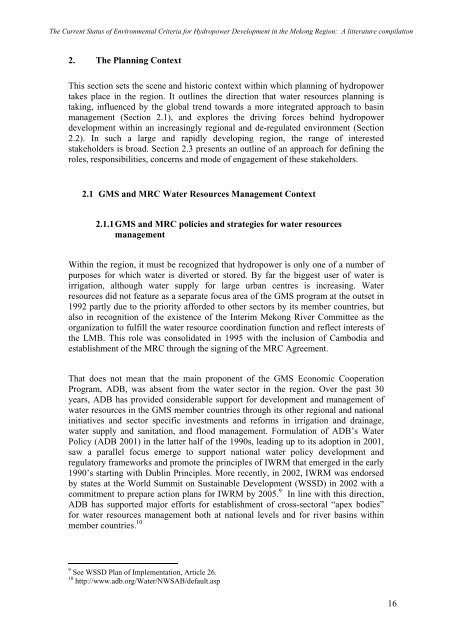Environmental Criteria for Hydropower in the Mekong Region - WWF
Environmental Criteria for Hydropower in the Mekong Region - WWF
Environmental Criteria for Hydropower in the Mekong Region - WWF
You also want an ePaper? Increase the reach of your titles
YUMPU automatically turns print PDFs into web optimized ePapers that Google loves.
The Current Status of <strong>Environmental</strong> <strong>Criteria</strong> <strong>for</strong> <strong>Hydropower</strong> Development <strong>in</strong> <strong>the</strong> <strong>Mekong</strong> <strong>Region</strong>: A litterature compilation<br />
2. The Plann<strong>in</strong>g Context<br />
This section sets <strong>the</strong> scene and historic context with<strong>in</strong> which plann<strong>in</strong>g of hydropower<br />
takes place <strong>in</strong> <strong>the</strong> region. It outl<strong>in</strong>es <strong>the</strong> direction that water resources plann<strong>in</strong>g is<br />
tak<strong>in</strong>g, <strong>in</strong>fluenced by <strong>the</strong> global trend towards a more <strong>in</strong>tegrated approach to bas<strong>in</strong><br />
management (Section 2.1), and explores <strong>the</strong> driv<strong>in</strong>g <strong>for</strong>ces beh<strong>in</strong>d hydropower<br />
development with<strong>in</strong> an <strong>in</strong>creas<strong>in</strong>gly regional and de-regulated environment (Section<br />
2.2). In such a large and rapidly develop<strong>in</strong>g region, <strong>the</strong> range of <strong>in</strong>terested<br />
stakeholders is broad. Section 2.3 presents an outl<strong>in</strong>e of an approach <strong>for</strong> def<strong>in</strong><strong>in</strong>g <strong>the</strong><br />
roles, responsibilities, concerns and mode of engagement of <strong>the</strong>se stakeholders.<br />
2.1 GMS and MRC Water Resources Management Context<br />
2.1.1 GMS and MRC policies and strategies <strong>for</strong> water resources<br />
management<br />
With<strong>in</strong> <strong>the</strong> region, it must be recognized that hydropower is only one of a number of<br />
purposes <strong>for</strong> which water is diverted or stored. By far <strong>the</strong> biggest user of water is<br />
irrigation, although water supply <strong>for</strong> large urban centres is <strong>in</strong>creas<strong>in</strong>g. Water<br />
resources did not feature as a separate focus area of <strong>the</strong> GMS program at <strong>the</strong> outset <strong>in</strong><br />
1992 partly due to <strong>the</strong> priority af<strong>for</strong>ded to o<strong>the</strong>r sectors by its member countries, but<br />
also <strong>in</strong> recognition of <strong>the</strong> existence of <strong>the</strong> Interim <strong>Mekong</strong> River Committee as <strong>the</strong><br />
organization to fulfill <strong>the</strong> water resource coord<strong>in</strong>ation function and reflect <strong>in</strong>terests of<br />
<strong>the</strong> LMB. This role was consolidated <strong>in</strong> 1995 with <strong>the</strong> <strong>in</strong>clusion of Cambodia and<br />
establishment of <strong>the</strong> MRC through <strong>the</strong> sign<strong>in</strong>g of <strong>the</strong> MRC Agreement.<br />
That does not mean that <strong>the</strong> ma<strong>in</strong> proponent of <strong>the</strong> GMS Economic Cooperation<br />
Program, ADB, was absent from <strong>the</strong> water sector <strong>in</strong> <strong>the</strong> region. Over <strong>the</strong> past 30<br />
years, ADB has provided considerable support <strong>for</strong> development and management of<br />
water resources <strong>in</strong> <strong>the</strong> GMS member countries through its o<strong>the</strong>r regional and national<br />
<strong>in</strong>itiatives and sector specific <strong>in</strong>vestments and re<strong>for</strong>ms <strong>in</strong> irrigation and dra<strong>in</strong>age,<br />
water supply and sanitation, and flood management. Formulation of ADB’s Water<br />
Policy (ADB 2001) <strong>in</strong> <strong>the</strong> latter half of <strong>the</strong> 1990s, lead<strong>in</strong>g up to its adoption <strong>in</strong> 2001,<br />
saw a parallel focus emerge to support national water policy development and<br />
regulatory frameworks and promote <strong>the</strong> pr<strong>in</strong>ciples of IWRM that emerged <strong>in</strong> <strong>the</strong> early<br />
1990’s start<strong>in</strong>g with Dubl<strong>in</strong> Pr<strong>in</strong>ciples. More recently, <strong>in</strong> 2002, IWRM was endorsed<br />
by states at <strong>the</strong> World Summit on Susta<strong>in</strong>able Development (WSSD) <strong>in</strong> 2002 with a<br />
commitment to prepare action plans <strong>for</strong> IWRM by 2005. 9 In l<strong>in</strong>e with this direction,<br />
ADB has supported major ef<strong>for</strong>ts <strong>for</strong> establishment of cross-sectoral “apex bodies”<br />
<strong>for</strong> water resources management both at national levels and <strong>for</strong> river bas<strong>in</strong>s with<strong>in</strong><br />
member countries. 10<br />
9 See WSSD Plan of Implementation, Article 26.<br />
10 http://www.adb.org/Water/NWSAB/default.asp<br />
16

















